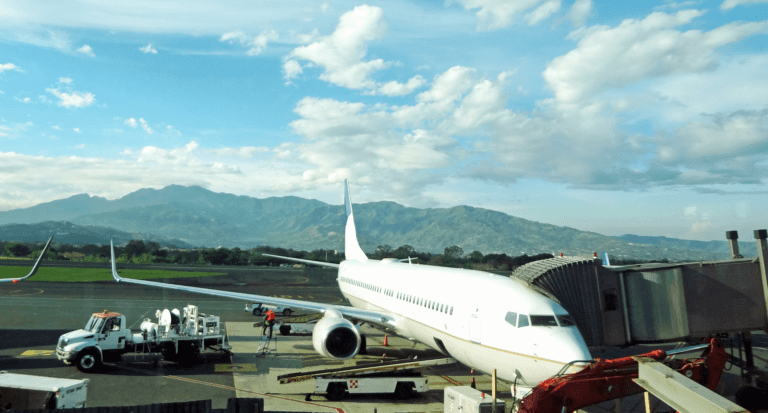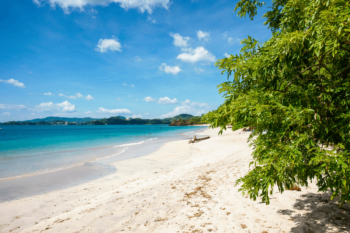Choosing the Right International Airport in Costa Rica: Quick Guide
Costa Rica has two international airports to choose from: Juan Santamaría (SJO) near San Jose and Daniel Oduber Quirós (LIR) in Guanacaste. SJO works best for Caribbean, Central Valley, and South Pacific destinations, while LIR gets you closer to Northern Pacific beaches like Tamarindo and Flamingo. Located 210 kilometers apart, your choice depends on where you’re headed first. Having a rental car from either airport opens up Costa Rica’s incredible diversity of landscapes and experiences.
Quick Facts:
- SJO sits 30 minutes from downtown San Jose, and LIR is just 15 minutes from Liberia
- SJO typically offers more affordable flight options with more airline choices
- Both airports require shuttle transport to the car rental offices
- Arrive 3 hours early at SJO, 2-3 hours at LIR for departure
- Domestic connections available at both airports through Sansa Air
Top Airport Choices by Destination:
- SJO Airport – Perfect for Puerto Viejo, Manuel Antonio, Monteverde, and the Osa Peninsula. More flight options mean better prices, though expect longer immigration lines on weekends.
- LIR Airport – Your gateway to Tamarindo, Nosara, Playas del Coco, and Rincon de la Vieja. Easier navigation and lighter traffic make driving from here straightforward.
- Both Work Well – La Fortuna, Monteverde, and Santa Teresa are accessible from either airport with similar drive times, giving you flexibility with flight schedules.
Whether you land in San Jose or Liberia, having reliable transportation transforms your Costa Rica experience. From navigating mountain roads to reaching hidden beaches, the right vehicle matches your adventure plans.
If you need any help with a Costa Rica car rental, contact us now!
Choose SJO (San José) if you’re exploring the Central Valley, Caribbean coast, Arenal volcano area, or southern Pacific beaches like Manuel Antonio. Pick LIR (Liberia) if you’re heading straight to Guanacaste’s beaches, including Tamarindo, Flamingo, or the Papagayo Peninsula resorts – you’ll be beachside within an hour of landing. The price difference between airports can reach $200+ per person, so if SJO saves you significant money and you don’t mind a 3-hour drive to Pacific beaches, it might be worth the extra road time.
Costa Rica’s two international airports serve completely different regions, and your choice shapes everything from your first-day logistics to which destinations you can realistically visit. Juan Santamaría International Airport (SJO) sits in Alajuela, about 20 kilometers from downtown San José, handling over 30 international airlines with competitive pricing. Daniel Oduber Quirós International Airport (LIR) in Liberia has transformed from a small regional facility into a modern gateway serving northwestern Costa Rica’s booming beach tourism.
Key Takeaways
- SJO works best for: Arenal/La Fortuna (3 hours), Monteverde (3.5 hours), Manuel Antonio (3 hours), the Caribbean coast, and multi-region trips
- LIR gets you to: Tamarindo in 1 hour, Papagayo resorts in 30 minutes, and most Guanacaste beaches within 90 minutes
- Flight prices vary: SJO typically offers more competitive fares with better scheduling flexibility
- Open-jaw tickets save time: Consider flying into one airport and out the other for two-week trips
- Domestic connections exist: Small aircraft connect remote areas like Drake Bay and Tortuguero through SJO
- Rental cars matter: Both airports have rental facilities, but advance booking is essential during December-April
Which Airport Gets You Closer to Costa Rica's Top Destinations?
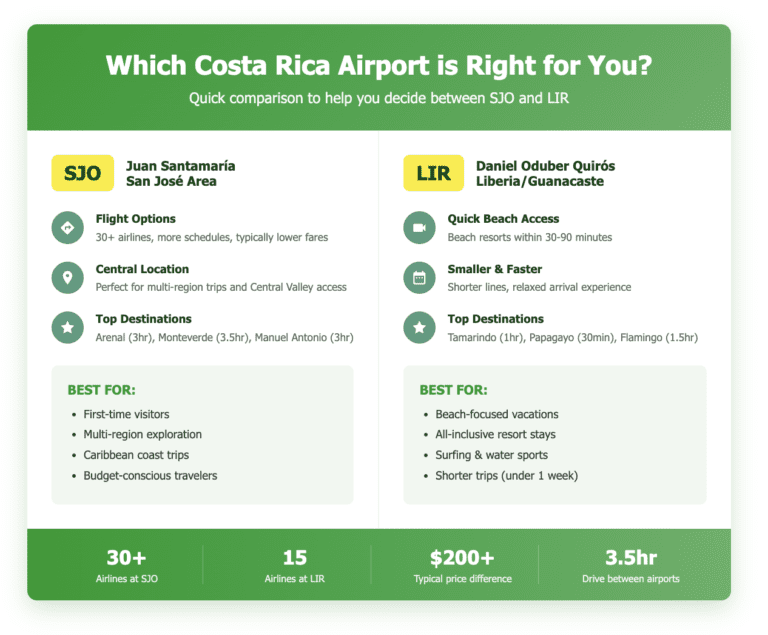
What Makes SJO the Better Choice for Central and Southern Destinations?
Juan Santamaría International Airport remains Costa Rica’s primary hub for good reason. Processing over 5 million passengers annually, SJO connects you to dozens of international carriers, typically offering more departure times and lower fares than Liberia.
The central location makes it ideal for first-timers wanting to explore multiple regions. From SJO, you’ll reach the famous Arenal Volcano and La Fortuna hot springs in about 3 hours, while cloud forest adventures in Monteverde require 3.5 hours of driving through scenic mountain roads.
When Does LIR Airport Make More Sense for Your Trip?
Daniel Oduber Quirós International Airport in Liberia has become the gateway of choice for beach lovers. If your Costa Rica dreams involve Tamarindo’s surf breaks or the all-inclusive resorts of Papagayo Peninsula, you’ll appreciate stepping off the plane and arriving at your beach hotel within an hour.
The smaller terminal means shorter immigration lines and a more relaxed arrival experience. Recent renovations added air conditioning throughout, modern restrooms, and improved dining options – though you’ll still find fewer amenities than SJO.
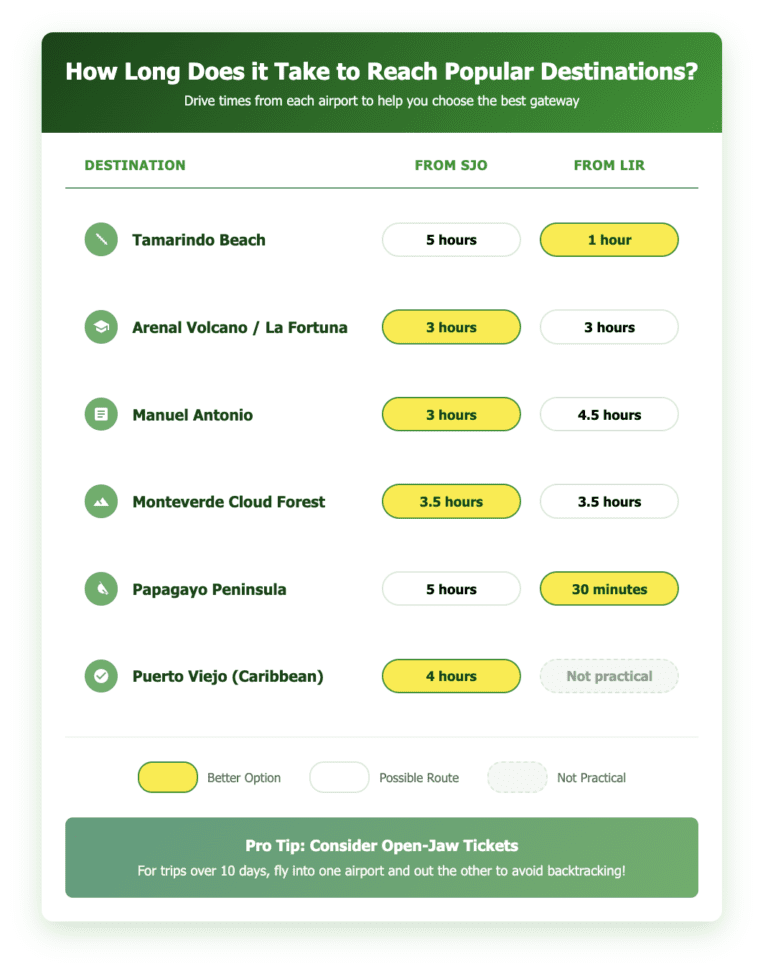
How Do Seasonal Patterns Affect Your Airport Decision?
What Changes During Dry Season (December-April)?
Both airports function smoothly during the dry season, but demand patterns differ significantly. LIR experiences peak crowds as beach tourism explodes, potentially leading to rental car shortages and higher accommodation prices near the airport.
Road conditions remain excellent throughout the country during these months. Even Monteverde’s notorious final stretch becomes manageable with a regular car, though 4×4 vehicles still provide better comfort and safety margins.
Book rental cars at least 2-3 months ahead for dry season travel. Last-minute availability disappears completely during Christmas, New Year’s, and Semana Santa (Easter Week).
How Does Green Season (May-November) Impact Airport Operations?
Afternoon thunderstorms can delay SJO flights more frequently than LIR during the green season. The Central Valley’s weather patterns create more fog and heavy rain around San José, occasionally causing schedule disruptions.
Interestingly, September and October bring Guanacaste’s driest “green season” weather, while the Central and Southern Pacific regions experience their rainiest periods. This makes LIR particularly attractive during these months when northern beaches enjoy sunshine while other regions see daily downpours.
Road conditions deteriorate during the green season, especially in unpaved sections. That scenic drive from SJO to Monteverde becomes more challenging, requiring genuine 4×4 capability rather than just higher clearance.
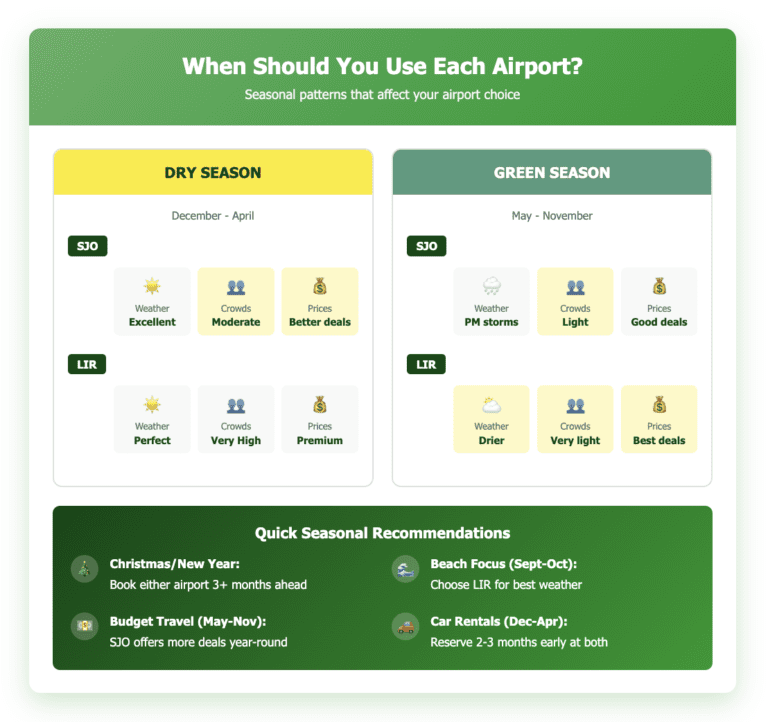
Which Airport Offers Better Flight Options and Pricing?
How Much Do Flight Prices Differ Between Airports?
SJO typically wins on pricing, sometimes by significant margins. The same dates might show $200-400 difference per person between airports, especially from East Coast departure cities. This price gap often justifies the longer drive to beach destinations.
Direct flight availability varies dramatically by departure city. Major hubs like Miami, Houston, and Atlanta serve both airports, while smaller cities might only connect through SJO. European flights almost exclusively use SJO, making it the obvious choice for international visitors from across the Atlantic.
What About Arrival and Departure Times?
Late-night arrivals work better at SJO, where numerous hotels cluster around the airport in Alajuela. The Hotel Buena Vista (4.5 rating on TripAdvisor) sits just 10 minutes away, offering free airport shuttles and an early breakfast for morning departures.
LIR has fewer nearby accommodation options, though the Hilton Garden Inn Liberia Airport (4.5 rating) provides convenient overnight stays just 10 minutes from the terminal.
Can You Use Domestic Flights to Skip Long Drives?
Which Remote Destinations Connect Through San José?
Small aircraft operate from SJO to remote areas, saving hours of challenging driving. Sansa and Costa Rica Green Airways fly 12-19-seat planes to destinations that would otherwise require full-day journeys.
Tortuguero’s canal-based ecosystem becomes accessible via a 30-minute flight versus a 4-5 hour combination of driving and boating. Drake Bay, gateway to Corcovado National Park on the Osa Peninsula, transforms from a 6+ hour odyssey into a comfortable 45-minute flight.

What Should You Know About Small Plane Travel?
Weather sensitivity becomes a real factor with these small aircraft. Afternoon storms frequently cancel flights during the green season, potentially stranding you overnight in remote locations.
The strict 30-pound baggage limit requires careful packing. Excess baggage often gets bumped to later flights, arriving hours or even days after you do. Pack essentials in a small carry-on that fits under your seat.
How Do Transportation Options Compare at Each Airport?
What Ground Transportation Works Best from Each Airport?
Public buses operate more frequently from SJO, with routes covering most of Costa Rica. The Tuasa bus to San José city center costs about $2 and runs every 20 minutes during daylight hours.
Private shuttles serve both airports, but with different coverage. Interbus and Grayline operate multiple daily departures from SJO to major tourist destinations. From LIR, shuttle options focus primarily on Guanacaste beach towns, with limited service to other regions.
Taxis from SJO to San José downtown cost $25-35, while reaching Manuel Antonio runs $160-180. From LIR, expect $50-60 to Tamarindo or $40 to nearby Papagayo resorts. Always agree on price before departure or insist on meter use (“la maria” in local Spanish).
Why Does Having a Rental Car Change Everything?
A rental car transforms your Costa Rica experience from scheduled transfers to spontaneous adventure. Both airports host major rental agencies, with Vamos Rentacar offering convenient pickup locations directly at each terminal.
The freedom to stop at roadside sodas (local restaurants) for authentic casados, pull over at spectacular viewpoints, or detour to that waterfall someone mentioned at breakfast – these spontaneous moments often become trip highlights.
During peak season, advance reservations become essential. Walk-up availability disappears completely around holidays, leaving travelers stranded or paying premium rates for whatever remains. Book at least 2-3 months ahead for December through April travel.

What’s Your Best Strategy for Multi-Region Trips?
Should You Consider Open-Jaw Tickets?
Flying into one airport and departing from the other eliminates backtracking on longer trips. Start with SJO to explore the Central Valley and Caribbean, work your way north through Arenal and Monteverde, then finish at Guanacaste beaches before flying home from LIR.
This approach typically adds $50-150 per ticket but saves a full day of driving. The time saved often justifies the minimal extra cost, especially on trips under two weeks, where every day counts.
How Do You Handle the Airport Transfer with a Rental Car?
Most agencies accommodate one-way rentals between airports for a fee ranging from $50-150. Confirm this option when booking, as not all companies offer this service during peak periods.
The drive between airports takes about 3.5 hours via Highway 1, passing through varied landscapes from mountain views to cattle ranches. Plan this as a travel day rather than trying to squeeze in activities – Costa Rican roads demand attention.
Which Airport Makes Sense for Your Specific Interests?
Where Should Wildlife Enthusiasts Fly Into?
SJO provides better access to Costa Rica’s biodiversity hotspots. The Caribbean’s Tortuguero protects crucial turtle nesting beaches, while the Osa Peninsula harbors 2.5% of the world’s biodiversity in Corcovado National Park.
From LIR, wildlife viewing focuses on dry forest species. Howler monkeys wake you at dawn throughout Guanacaste, while Santa Rosa and Rincón de la Vieja National Parks protect unique ecosystems found nowhere else in Costa Rica.
What About Adventure Activities and Special Interests?
Whitewater rafting on the Pacuare River, canyoning in La Fortuna, and coffee farm tours in the Central Valley all favor SJO arrival. The airport’s central position provides easier access to Costa Rica’s adventure activity corridor.
Surfing, sportfishing, and sailing clearly favor LIR. Tamarindo alone offers dozens of surf schools, while world-class fishing charters depart from Flamingo and Playas del Coco. The consistent winds from December through April make Guanacaste ideal for sailing and kitesurfing.

Your Airport Decision: Making It Work
The “right” airport depends entirely on your priorities. Beach-focused trips lasting under a week? LIR saves precious vacation hours. Planning to explore multiple regions or seeking the “classic” Costa Rica experience with volcanoes, cloud forests, and wildlife? SJO’s central location and better connectivity make more sense.
Consider your comfort with driving, too. Routes from Liberia tend toward flat, straight highways. Journeys from San José often involve mountain passes with dramatic elevation changes and countless curves – spectacular but demanding.
For your best Costa Rica experience, book flights into whichever airport offers reasonable prices, then plan your itinerary around that choice. With proper planning and reliable transportation, either gateway opens doors to unforgettable adventures. Whether you’re picking up your Vamos rental car at SJO or LIR, the journey from either airport becomes part of the adventure rather than just a transfer to overcome.
Ready to lock in your plans? Compare current flight prices to both airports, check rental car availability for your dates, and remember that the “perfect” choice is the one that gets you to Costa Rica. Sometimes overthinking the details prevents booking the trip – and any day in Costa Rica beats another day of planning from home.
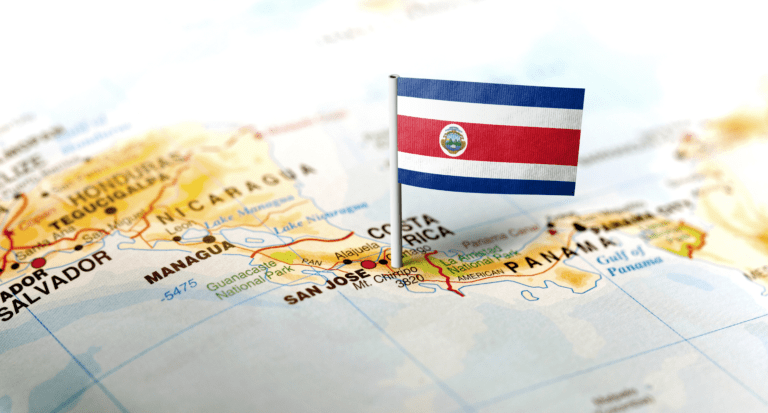
Frequently Asked Questions
Which airport should I fly into in Costa Rica?
Choose SJO if you’re exploring multiple regions, visiting Arenal volcano, Monteverde cloud forest, or the Caribbean coast. Pick LIR if you want to hit the beach fast – you’ll be in Tamarindo within an hour or at Papagayo resorts in 30 minutes. Price matters too: SJO typically runs $200+ cheaper per person than LIR, so if you don’t mind driving 3 hours to reach Pacific beaches, the savings might be worth it.
What is the cheapest airport to fly into in Costa Rica?
SJO (San José) consistently offers better deals, with tickets often $200-400 less per person than Liberia. The trade-off? You’ll spend more time driving to Guanacaste beaches. Miami, Houston, and Fort Lauderdale typically have the most competitive fares to both airports. Book Tuesday afternoons for the best prices, and set price alerts 2-3 months before travel. Remember to factor in transportation costs – that cheaper SJO ticket might balance out after adding a longer rental car period or private shuttle fees.
How far apart are the two airports in Costa Rica?
The drive between SJO and LIR takes about 3.5 hours via Highway 1, covering roughly 215 kilometers through varied terrain – from Central Valley coffee farms to Guanacaste’s dry forests. If you’re considering an open-jaw ticket (flying into one, out the other), this works well for trips over 10 days. The route is straightforward but demands attention, especially around the winding sections near Cañas. Most rental agencies, including Vamos, accommodate one-way rentals between airports for a fee of $50-150.
Is it better to fly into SJO or LIR?
Neither is universally “better” – it depends on your priorities. SJO wins for variety: more flights, better prices, and central access to diverse regions. You’ll need it for Arenal, Monteverde, Manuel Antonio, or Caribbean destinations. LIR wins for beach convenience: shorter immigration lines, quick resort access, and less driving on arrival day. During September-October, LIR enjoys better weather while the Central Pacific sees heavy rain. For trips under a week focused on beaches, choose LIR. For everything else, SJO’s flexibility usually wins.
Where is the best place to go in Costa Rica for first-time visitors?
First-timers typically love the Arenal-Monteverde-Manuel Antonio circuit, making SJO your best entry point. This classic route combines volcano views, hot springs, cloud forest adventures, and beach time in about 7-10 days. Start in La Fortuna for Arenal volcano and hot springs (3 hours from SJO), then tackle Monteverde’s cloud forest before ending at Manuel Antonio’s beaches, where rainforest meets ocean. This itinerary showcases Costa Rica’s biodiversity without excessive driving. A 4×4 rental handles all these roads comfortably, even during the green season.
What are the two major airports in Costa Rica?
Juan Santamaría International Airport (SJO) near San José handles over 5 million passengers annually as the country’s main hub. Daniel Oduber Quirós International Airport (LIR) in Liberia serves the northwestern Guanacaste province. While there are smaller domestic airstrips like Quepos and Tambor, SJO and LIR are your only real international options. Both have been modernized recently – SJO offers more services and dining options, while LIR provides a smaller, easier-to-navigate terminal that gets you to beach resorts quickly.
Where in the US flies direct to Costa Rica?
From SJO, you’ll find direct flights from Miami, Fort Lauderdale, Orlando, Atlanta, Houston, Dallas, Newark, JFK, Los Angeles, Denver, Phoenix, and Charlotte. LIR has fewer but growing options: Miami, Houston, Dallas, Atlanta, Los Angeles, Denver, Newark, and seasonally from Chicago and Minneapolis. Southwest, United, and American offer the most routes. East Coast cities typically serve both airports, while some West Coast flights only go to SJO. During high season (December-April), additional direct routes open up, especially to LIR.
How many days do you need in Costa Rica?
A week allows you to properly explore 2-3 destinations without feeling rushed. Ten days is the sweet spot – enough time for the classic volcano-cloud forest-beach combination with actual relaxation built in. Two weeks lets you add the Caribbean coast or venture south to the Osa Peninsula. Anything less than 5 days? Pick one region and stay put. Remember that Costa Rican roads make travel days real commitments – that “quick” drive from La Fortuna to Manuel Antonio takes 3.5 hours of full attention on mountain roads.

